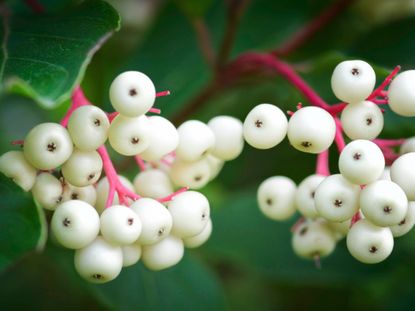Gray Dogwood Care - Learn About The Gray Dogwood Shrub


The gray dogwood isn't a tidy or attractive plant that you would want to plant in a well-groomed garden, but if you are planting a wildlife area or want a shrub for difficult conditions, it may be just what you need. Read on for information about this humble shrub.
Gray Dogwood Information
Gray dogwood (Cornus racemosa) is rangy and even a little scraggly, with suckers springing up all around it. The fall leaves are dark reddish purple, and while the color is interesting, you wouldn't call it attractive. The white winter berries only last a short time and don't add much to the appearance of the shrub. Although you may not want to plant it in a formal garden, it is right at home in a wildlife area or a location with poor, wet soil. As wildlife plants, gray dogwood thickets provide shelter, hiding places, and nesting sites for birds and small mammals. Several species of birds eat the berries, including Eastern bluebirds, Northern cardinals, Northern flickers, and downy woodpeckers. The flowers attract butterflies, and some species use them as larval host plants.
Growing Gray Dogwoods
Although you can grow it as a tree, a gray dogwood tree soon becomes a multi-stemmed shrub without constant attention in removing the suckers. Growing gray dogwood shrubs in a row provides a screen against unsightly views, strong winds, and harsh sunlight. Gray dogwood care is a snap too. The shrubs thrive in full sun or partial shade and almost any soil. They aren't bothered by air pollution. These shrubs tolerate dry soil, so they seldom need watering, and never need fertilizer. The biggest task in caring for gray dogwood is keeping the suckers at bay. Pull them up whenever possible. If you have to cut them, cut them at the source below the surface of the soil. Partially removed suckers soon return.
Is Gray Dogwood Invasive?
Any plant growing in its native range has natural controls to keep it in check, so native plants aren't invasive. Gray dogwood is a native plant that is not considered invasive in any part of the U.S. In fact, it is recommended as an alternative to invasive shrubs such as non-native honeysuckle. Gray dogwood can, however, become aggressive in the landscape. It produces multiple suckers that become new stems. Over time, the shrub forms a thicket unless it's thinned from time to time.
Gardening tips, videos, info and more delivered right to your inbox!
Sign up for the Gardening Know How newsletter today and receive a free download of our most popular eBook "How to Grow Delicious Tomatoes."

Jackie Carroll has written over 500 articles for Gardening Know How on a wide range of topics.
-
 Urban Composting Guide: How To Compost In The Middle Of The City
Urban Composting Guide: How To Compost In The Middle Of The CityUrban composting does not have to be daunting. You can compost in the city, and maybe even try some urban worm composting!
By Mary Ellen Ellis
-
 Shrub Diseases And Pests To Watch Out For
Shrub Diseases And Pests To Watch Out ForShrub diseases and pests can be challenging. Learn how to recognize and eradicate them before they can present a danger to your plants.
By Susan Albert